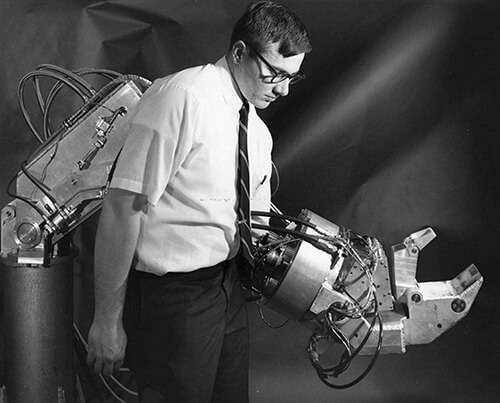How Sci-Fi Robotic Gear May Help Older Workers
Exoskeletons of the future could boost workers' mobility and strength
The Rise of the Exoskeletons sounds like a science fiction motion picture coming to a theater near you. But it’s really an exciting development for future retirees and unretirees that just might help you work as long as you like.
Scientists, researchers and high-tech companies are turning into reality the kind of mechanical marvels boomers lapped up watching The Six Million Dollar Man and RoboCop. The recent progress is nothing short of stunning, holding out the promise that exoskeletons and related robotic technologies could overcome the kinds of disabilities that prevent many older Americans from working. “Soon, we will have exoskeletons that improve mobility for older people,” says Steve Collins, professor in the Department of Mechanical Engineering and the Robotics Institute at Carnegie Mellon University.
What Exoskeletons Can Do
Exoskeleton means "outer skeleton,” and it’s common in nature. (Think grasshoppers and lobsters, cockroaches and snails.) Robotic exoskeletons for humans are designed to offer people additional protection, support and strength.
Much of the current exoskeleton effort is geared toward aiding the seriously disabled and members of the military. For example, roboticists are developing exoskeletons that let the wheelchair-bound stand and move around and experiments with soldiers wearing exoskeletons show they can stay nimble on the battlefield despite wearing heavy armor protection. A hint of the power of the exoskeleton future came during a moving moment in the 2014 World Cup when a paraplegic wearing an Iron Man-like suit kicked the opening ball.
Boosting Productivity and Reducing Injuries at Work
Less appreciated is how exoskeletons are starting to enter the workplace, at least on an experimental level. Take the ones being tested by Lockheed Martin and BAE Systems (and described in The Economist last December) with the support of the National Center for Manufacturing Sciences (a cross-industry consortium), the Department of Defense and others.
These lightweight exoskeleton frames allow operators of heavy tools — those used at naval shipyards decommissioning ships, for example — to handle them as if they were weightless. The evidence so far is that the exoskeletons significantly boost worker productivity and reduce the risk of injury.
For example, BAE Systems’ exoskeleton “minimizes pressure on the wearer’s lower back, hips, knees and ankles while improving posture and reducing the risk of injury,” according to a National Center for Manufacturing Sciences evaluation.

Impressive, isn’t it? As exoskeletons like this develop and become widespread in industrial America, blue-collar workers might not be forced to retire early, worn down by the physical demands of manufacturing and construction work.
(For more detailed information on the Lockheed Martin and BAE Systems exoskeletons, read this description of them. And for fun, go to Cyberneticzoo.com to compare those with the Hardiman 1 Project, a 1,500-pound “powered exoskeleton” developed by the military and General Electric from 1965 to 1971.
The Walking Assist Clutch
Partial exoskeletons that improve mobility should also show up at office within the foreseeable future.
Take the Walking Assist Clutch demonstrated last year by Collins, Greg Sawicki (a professor at the North Carolina State University/University of North Carolina-Chapel Hill department of Biomedical Engineering) and their colleagues. The spring-and-ratchet exoskeleton was designed to help stroke victims walk more easily, but once commercially available, I imagine the device will help some aging boomers move around more easily on the job.
The Clutch is worn around the ankles, weighs about a pound and allows the walker to expend 7 percent less energy. That may not sound like much of an improvement, but it’s the equivalent of taking off a 10-pound backpack.
The groundbreaking technology is a lab research product at the moment, with scientists refining the device — including coming up with a version that will run off the equivalent of a watch battery. “Things are moving fast,” says Collins. “We are starting to figure out how to help people get around.” (You can watch videos of it at Collins’ Carnegie Mellon webpage.
What's Holding Things Back
To be sure, despite the rapid pace of technological advances, the current generation of exoskeletons is mostly in the R&D phase. A big barrier to the more ambitious visions of exoskeletons in science fiction is the lack of a strong, long-lasting power source.
University of Arizona neuroscientist and roboticist Charles Higgins says when he saw the dystopian movie Elysium, where Matt Damon wore a full-body, highly-flexible exoskeleton giving him superhuman strength, “I wondered, ‘Where is the power supply?’ Our power technology isn’t there to do what you see in the movies. A full exoskeleton is still in the fantasy stage.”
That said, the rise of more prosaic and practical exoskeletons will play a critical supporting role in assisting everyday humans to work extra years.
Several years ago, Joseph Coughlin, head of MIT’s AgeLab, predicted that, “In the near future the ‘new kid down the hall’ may, in fact, be someone’s grandmother in the next stage of her multi-act life.” It was a catchy way to capture the unretirement trend.
Maybe we should add to his insight that some of those new colleagues will be enjoying their unretirement because exoskeleton devices like the Walking Assist Clutch will help them get around the workplace and earn more money which will then help crank up the size of their retirement funds. Hmm… The Six Million Dollar Man?


